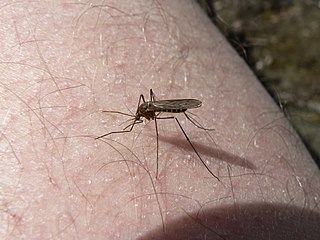
Convolvulaceae, known commonly as the bindweed or morning glory family, is a family of about 60 genera and more than 1,650 species of mostly herbaceous vines, but also trees, shrubs and herbs, and also including the sweet potato and a few other food tubers.
Eastern equine encephalitis (EEE), commonly called Triple E or sleeping sickness, is a disease caused by a zoonotic mosquito vectored Togavirus that is present in North, Central, and South America, and the Caribbean. EEE was first recognized in Massachusetts, United States, in 1831, when 75 horses died mysteriously of viral encephalitis. Epizootics in horses have continued to occur regularly in the United States. It can also be identified in donkeys and zebras. Due to the rarity of the disease, its occurrence can cause economic impact beyond the cost of horses and poultry. EEE is found today in the eastern part of the United States and is often associated with coastal plains. It can most commonly be found in East Coast and Gulf Coast states. In Florida, about one to two human cases are reported a year, although over 60 cases of equine encephalitis are reported. In years in which conditions are favorable for the disease, the number of equine cases is over 200. Diagnosing equine encephalitis is challenging because many of the symptoms are shared with other illnesses and patients can be asymptomatic. Confirmations may require a sample of cerebral spinal fluid or brain tissue, although CT scans and MRI scans are used to detect encephalitis. This could be an indication that the need to test for EEE is necessary. If a biopsy of the cerebral spinal fluid is taken, it is sent to a specialized laboratory for testing.

Culiseta is a genus of mosquitoes. Most Culiseta species are cold-adapted, and only occur in warmer climates during the colder parts of the year or at higher elevations where temperatures are lower. Species found in Southern California are larger than most mosquitoes species, specifically Cs. inornata, Cs. particeps, and Cs. incidens. These species are found throughout the year in Southern California and feed on several vertebrate species, such as birds, livestock, rodents, reptiles, and humans. The larvae of most species are found bogs, marshes, ponds, streams, ditches, and rock pools, but an African species occurs in tree holes ("phytotelmata"), a common eastern Palaearctic species occurs in water wells and rock pools, and several Australian species occur under ground. Little is known about the blood-feeding habits of females. Most species feed on birds and mammals, but a few feed on reptiles. Several species attack domestic animals and occasionally humans, and some species are pollinators.

Ephraim Porter Felt was an American entomologist who specialised in Diptera.

Culiseta longiareolata is a species of mosquito.

Culiseta annulata is a species of mosquito in the family Culicidae. It is found in the Palearctic.
Culiseta novaezealandiae is a species of mosquito. It is endemic to New Zealand. It is found in Southland and Otago. This species was first described by J. S. Pillai in 1966 using specimens collected at Tahakopa. The habitat of this species in its larval stage is coastal broadleaf swamp. It has been hypothesised that the hosts of C. novaezealandiae are birds. This mosquito species is regarded as being unlikely to be an arbovirus vector.
Culiseta melanura, the black-tailed mosquito, is a species of mosquito in the family Culicidae. Since adult female Culiseta melanura primarily take their blood meals from birds, they are responsible for transmitting eastern equine encephalitis virus between birds. Humans, horses, and other mammals become infected with eastern equine encephalitis virus when other mosquito species besides Culiseta melanura, such as Aedes, Coquillettidia, and Culex species take blood meals first from infected birds and then later take blood meals from mammals, transferring the virus to these hosts.
Triarius trivittatus is a species of skeletonizing leaf beetle in the family Chrysomelidae. It is found in North America.

Culiseta incidens, the cool weather mosquito, is a species of mosquito in the family Culicidae.
Milesia scutellata is a species of syrphid fly in the family Syrphidae.
Mixogaster breviventris is a species of syrphid fly in the family Syrphidae.
Chrysotoxum chinook is a species of syrphid fly in the family Syrphidae.
Aradus funestus is a species of flat bug in the family Aradidae. It is found in North America.
Aradus depictus is a species of flat bug in the family Aradidae. It is found in North America.

Culiseta inornata, the winter marsh mosquito, is a species of mosquito in the family Culicidae.

Culiseta impatiens is a species of mosquito in the family Culicidae.
Sphecomyia nasica is a species of syrphid fly in the family Syrphidae.
Spilomyia liturata is a species of syrphid fly in the family Syrphidae.
Animal Ethics is a nonprofit organization formed to promote discussion and debate around issues in animal ethics and to provide information and resources for animal advocates. They also do outreach work in several countries on the issue of speciesism. Their aim is to create a world where moral consideration is extended to all sentient beings. The organization's website covers topics such as speciesism, sentience, veganism and wild animal suffering and has content translated into several languages.






